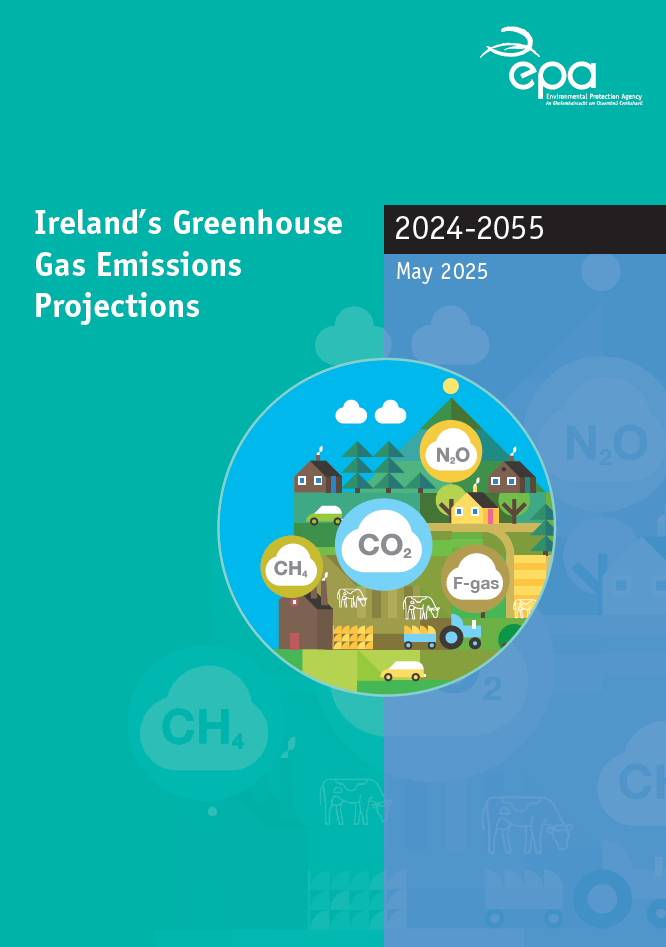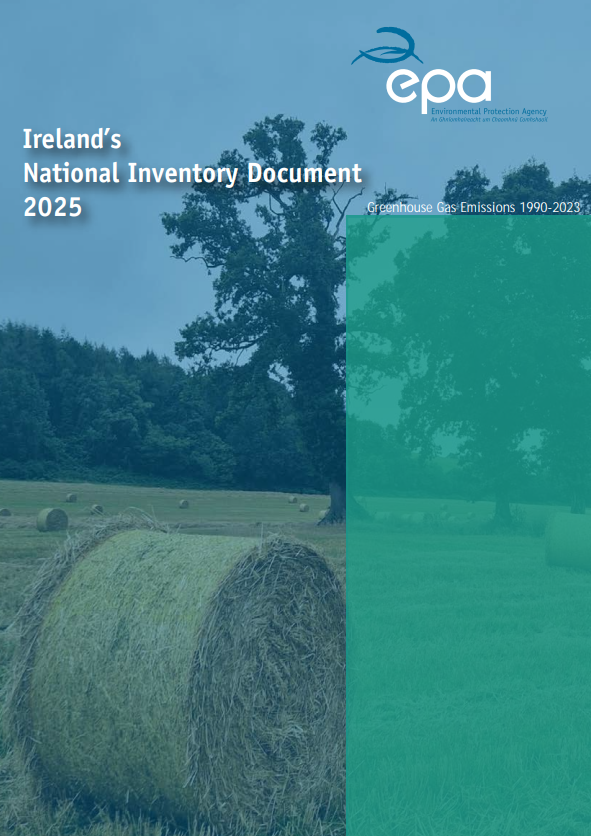
Quarterly Greenhouse Gas Emissions Indicator Report 2024 Quarter 4
Year: 2025
This is the fourth EPA report in a new series of quarterly greenhouse gas emissions for Ireland to support more frequent monitoring of national and sectoral progress on climate action. The series will complement the national greenhouse gas inventory and projections prepared annually by the EPA. Emissions in quarter 4 2024 were up by 2.5 per cent on the same quarter last year. This was mainly driven by increased emissions from electricity generation (+11.3 per cent), and agriculture (+3.8 per cent). It should be noted that these data have been seasonally adjusted to provide a clearer picture of the underlying trends independent of seasonal fluctuations.

Quarterly Greenhouse Gas Emissions Indicator Report 2024 Quarter 3
Year: 2025
This is the third EPA report in a new series of quarterly greenhouse gas emissions for Ireland to support more frequent monitoring of national and sectoral progress on climate action. The series will complement the national greenhouse gas inventory and projections prepared annually by the EPA. Emissions in quarter 3 2024 increased by +0.5% (+60 kt CO₂ eq) compared to quarter 3 2023, driven mainly by increases in the Buildings (+162 kt CO₂ eq) sector (due to increased heating demand from cooler weather) and Agriculture (+99 kt CO₂ eq) sector (due to increased fertiliser use).

National Climate Change Risk Assessment Summary for Policymakers
Year: 2025
Ireland’s first National Climate Change Risk Assessment (NCCRA) provides a comprehensive national overview of the potential risks and opportunities posed by climate change for Ireland. It will play a critical role in meeting national policy objectives and supporting sectoral and local authority climate adaptation planning processes. The NCCRA integrates scientific and technical knowledge with input from expert stakeholders, to identify, assess, and prioritise climate change risks to build a comprehensive understanding of risks.

National Climate Change Risk Assessment Technical Report
Year: 2025
Ireland’s first National Climate Change Risk Assessment (NCCRA) provides a comprehensive national overview of the potential risks and opportunities posed by climate change for Ireland. It will play a critical role in meeting national policy objectives and supporting sectoral and local authority climate adaptation planning processes. The NCCRA integrates scientific and technical knowledge with input from expert stakeholders, to identify, assess, and prioritise climate change risks to build a comprehensive understanding of risks.

National Climate Change Risk Assessment Main Report
Year: 2025
Ireland’s first National Climate Change Risk Assessment (NCCRA) provides a comprehensive national overview of the potential risks and opportunities posed by climate change for Ireland. It will play a critical role in meeting national policy objectives and supporting sectoral and local authority climate adaptation planning processes. The NCCRA integrates scientific and technical knowledge with input from expert stakeholders, to identify, assess, and prioritise climate change risks to build a comprehensive understanding of risks.

Ireland's Greenhouse Gas Emissions Projections 2024-2055
Year: 2025
This report provides an assessment of Ireland’s total projected greenhouse gas emissions out to 2055 which includes an assessment of progress towards achieving its National ambitions under the Climate Action and Low Carbon Development (Amendment) Act 2021 and EU emission reduction targets for 2030 as set under the EU Effort Sharing Regulation (Regulation (EU) 2018/842).
PFOA i gCúir Chomhraicthe Dóiteáin
Year: 2025
SEA Spatial Information Sources Inventory
EPA Spatial Data Inventory, May 2025
Year: 2025
This inventory of spatial information sources can be used to help in preparing SEA Environmental Reports and the associated environmental assessments with up to date environmental information. Data sources/links include air quality, climate, biodiversity, flora, fauna, geology, soils, hydrology and water quality. This inventory was last updated in May 2025 and may not be exhaustive. (See Disclaimer below for terms of use).
Eionet Ireland Network Brochure May 2025
Year: 2025
National Focal Points (NFPs) are the primary national contact points in the Eionet and the EEA works closely with them. Typically based in a national environment agency or environment ministry an NFP is appointed by their EEA member country. The Environmental Protection Agency acts as the NFP for Ireland, coordinating environmental information exchange with the EEA and others. In its NFP role, the EPA maintains and develops the national network. It also facilitates and coordinates contacts, requests and deliveries between national and EU level. The summary booklet was updated in May 2025.

Hydrology Summary Bulletin - April 2025
Hydrology bulletin on rainfall, river flows, lake levels, groundwater levels and spring outflows for April 2025, May 2025
Year: 2025
Hydrology Summary Bulletin outlining the flows in rivers, rainfall, lake and turlough levels, groundwater levels and spring outflows of over 300 stations across Ireland for the month

Bathing water quality in Ireland in 2024
Year: 2025
This is a report about bathing water quality in Ireland during 2024

Ireland's Air Pollutant Emissions 2023 (1990-2030)
Year: 2025
Latest report (2025) on Ireland's National Emission Reduction Commitment Directive (NECD) emissions. Five main air pollutants, NOx, SO2, NH3, NMVOC and PM2.5

Ireland's Final Greenhouse Gas Emissions 1990-2023
Year: 2025
The EPA has produced final estimates of greenhouse gas emissions for the time period 1990-2023.

GREENHOUSE GASES: A global to national overview of impacts, trends and policy
Year: 2025
An overview of greenhouse gases, where they come from in Ireland and how we can mitigate them.

Hydrology Summary Bulletin - March 2025
Hydrology bulletin on rainfall, river flows, lake levels, groundwater levels and spring outflows for March 2025., April 2025
Year: 2025
Hydrology Summary Bulletin outlining the flows in rivers, rainfall, lake and turlough levels, groundwater levels and spring outflows of over 300 stations across Ireland for the month

Climate Attitudes and Literacy in the Civil Service (CALCS)
2025, March 2025
Year: 2025
The Climate Attitudes and Literacy in the Civil Service (CALCS) report examines beliefs, attitudes, policy preferences and behaviours regarding climate change among civil servants in Ireland.

Climate Change in the Irish Mind Insight Report Wave 2 No. 1:
Life Stage, March 2025
Year: 2025
Climate Change in the Irish Mind Insight Report Wave 2 No. 1 Life Stage concentrates on how life stage relates to the pattern of responses to Climate Change in the Irish Mind climate change beliefs and risk perceptions questions.

Early insights indicator report: Nitrogen concentrations in selected major rivers, January-December 2024
Year: 2025
The purpose of this report is to provide an early insight into nitrogen concentrations in major rivers in Ireland, in advance of the more comprehensive annual water quality assessments.

Ireland's National Inventory Submissions 2025
Year: 2025
Ireland's annual inventory submissions including the National Inventory Document (NID) and Common Reporting Table (CRT) data files and supplementary information if available. The NID contains transparent and detailed information on the inventory for years 1990-2023. The CRT tables contain all greenhouse gas (GHG) emissions and removals, implied emission factors and activity data..

Ireland's UNECE Submissions 2025
Year: 2025
Ireland's submissions under UNECE Convention on Long-Range Transboundary Air Pollution (CLRTAP) and National Emissions Ceiling Directive (NECD) include the Informative Inventory Report (IIR) and Nomenclature for Reporting (NFR) tables. The IIR and NFR contain detailed information on methodologies, activity data and emission factors and emissions for years 1990-2023.